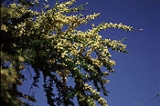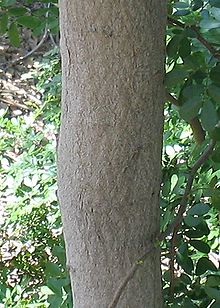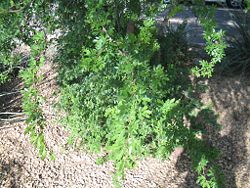
Acacia rigidula
Encyclopedia


Fabaceae
The Fabaceae or Leguminosae, commonly known as the legume, pea, or bean family, is a large and economically important family of flowering plants. The group is the third largest land plant family, behind only the Orchidaceae and Asteraceae, with 730 genera and over 19,400 species...
. Its native range stretches from Texas
Texas
Texas is the second largest U.S. state by both area and population, and the largest state by area in the contiguous United States.The name, based on the Caddo word "Tejas" meaning "friends" or "allies", was applied by the Spanish to the Caddo themselves and to the region of their settlement in...
in the United States
United States
The United States of America is a federal constitutional republic comprising fifty states and a federal district...
south to central Mexico
Mexico
The United Mexican States , commonly known as Mexico , is a federal constitutional republic in North America. It is bordered on the north by the United States; on the south and west by the Pacific Ocean; on the southeast by Guatemala, Belize, and the Caribbean Sea; and on the east by the Gulf of...
. This perennial is closely related to A. berlandieri
Acacia berlandieri
Acacia berlandieri is a shrub native to the Southwestern United States and northeast Mexico that belongs to the subfamily Mimosoideae of Fabaceae . It grows tall, with blossoms that are spherical and white, occurring from February through April...
and is not listed as being threatened. It reaches a height of 5–15 ft (1.5–4.6 m). Blackbrush Acacia grows on limestone
Limestone
Limestone is a sedimentary rock composed largely of the minerals calcite and aragonite, which are different crystal forms of calcium carbonate . Many limestones are composed from skeletal fragments of marine organisms such as coral or foraminifera....
hillsides and canyons.
Phytochemistry
A 1998 paper in the journal PhytochemistryPhytochemistry (journal)
Phytochemistry is a journal covering pure and applied plant chemistry, plant biochemistry and molecular biology. It is published by Elsevier.-Indexing:Phytochemistry is indexed in:...
indicates that the leaves and stems of A. rigidula contain 40 alkaloid
Alkaloid
Alkaloids are a group of naturally occurring chemical compounds that contain mostly basic nitrogen atoms. This group also includes some related compounds with neutral and even weakly acidic properties. Also some synthetic compounds of similar structure are attributed to alkaloids...
s and amine
Amine
Amines are organic compounds and functional groups that contain a basic nitrogen atom with a lone pair. Amines are derivatives of ammonia, wherein one or more hydrogen atoms have been replaced by a substituent such as an alkyl or aryl group. Important amines include amino acids, biogenic amines,...
s, including:
- 3,4,5-Trihydroxy-phenethylamine (demethylated mescaline)
- MethamphetamineMethamphetamineMethamphetamine is a psychostimulant of the phenethylamine and amphetamine class of psychoactive drugs...
- Anhalamine
- Beta-methyl-phenethylamineBeta-methyl-phenethylamineβ-Methylphenethylamine is a stimulant drug of the phenethylamine chemical class that is related to amphetamine . It is found in Acacia species i.e. Acacia rigidula, Acacia greggii, Acacia schaffneri and notably Acacia berlandieri . The latter produces a paralytic condition in livestock....
- CatechinCatechinCatechin is a natural phenol antioxidant plant secondary metabolite. The term catechins is also commonly used to refer to the related family of flavonoids and the subgroup flavan-3-ols ....
- DimethyltryptamineDimethyltryptamineN,N-Dimethyltryptamine is a naturally occurring psychedelic compound of the tryptamine family. DMT is found in several plants, and also in trace amounts in humans and other mammals, where it is originally derived from the essential amino acid tryptophan, and ultimately produced by the enzyme INMT...
– 323.8 ppm spring, 568.4 ppm fall - FisetinFisetinFisetin is a flavonol, a structurally distinct chemical substance that belongs to the flavonoid group of polyphenols. It can be found in many plants, where it serves as a colouring agent...
- HordenineHordenineHordenine is a phenethylamine alkaloid with antibacterial and antibiotic properties. It stimulates the release of norepinephrine in mammals, working as a stimulant...
- MescalineMescalineMescaline or 3,4,5-trimethoxyphenethylamine is a naturally occurring psychedelic alkaloid of the phenethylamine class used mainly as an entheogen....
- N-MethyltryptamineN-MethyltryptamineN-Methyltryptamine , or methyltryptamine, is a member of the tryptamine chemical class. It is an alkaloid, probably derived from L-tryptophan, that has been found in the bark, shoots and leaves of several plant species, including Virola, Acacia, Mimosa and Desmanthus often together with the...
– 4.6 ppm spring, 54.9 ppm fall - NicotineNicotineNicotine is an alkaloid found in the nightshade family of plants that constitutes approximately 0.6–3.0% of the dry weight of tobacco, with biosynthesis taking place in the roots and accumulation occurring in the leaves...
- Nornicotine
- PhenethylaminePhenethylaminePhenylethylamine or phenethylamine is a natural monoamine alkaloid, trace amine, and also the name of a class of chemicals with many members well known for psychoactive drug and stimulant effects. Studies suggest that phenylethylamine functions as a neuromodulator or neurotransmitter in the...
– 2314.6 ppm spring, 5264.8 ppm fall - QuercetinQuercetinQuercetin , a flavonol, is a plant-derived flavonoid found in fruits, vegetables, leaves and grains. It also may be used as an ingredient in supplements, beverages or foods.-Occurrence:...
- TyramineTyramineTyramine is a naturally occurring monoamine compound and trace amine derived from the amino acid tyrosine. Tyramine acts as a catecholamine releasing agent...
- TryptamineTryptamineTryptamine is a monoamine alkaloid found in plants, fungi, and animals. It is based around the indole ring structure, and is chemically related to the amino acid tryptophan, from which its name is derived...
– 0.8 ppm spring, 21.2 ppm fall
These findings have never been confirmed or discussed and are considered by some to be unlikely and a product of contamination or a hoax. Some of the apparently found phenylethylamines were previously only known as man-made and their discovery would have been quite revolutionary. Also the authors of the 1998 study did not answer written requests.
Uses
Blackbrush Acacia is used in weight loss dietary supplementDietary supplement
A dietary supplement, also known as food supplement or nutritional supplement, is a preparation intended to supplement the diet and provide nutrients, such as vitamins, minerals, fiber, fatty acids, or amino acids, that may be missing or may not be consumed in sufficient quantities in a person's diet...
s because of its adrenergic amine
Amine
Amines are organic compounds and functional groups that contain a basic nitrogen atom with a lone pair. Amines are derivatives of ammonia, wherein one or more hydrogen atoms have been replaced by a substituent such as an alkyl or aryl group. Important amines include amino acids, biogenic amines,...
content. These substances stimulate beta-receptors
Adrenergic receptor
The adrenergic receptors are a class of metabotropic G protein-coupled receptors that are targets of the catecholamines, especially noradrenaline and adrenaline ....
to increase lipolysis
Lipolysis
Lipolysis is the breakdown of lipids and involves the hydrolysis of triglycerides into free fatty acids followed by further degradation into acetyl units by beta oxidation. The process produces Ketones, which are found in large quantities in ketosis, a metabolic state that occurs when the liver...
and metabolic rate and decrease appetite.
External links


